
There’s nothing sophisticated about catching triggerfish out of Oregon Inlet. It’s best to keep it simple.
The order of the day was bottom-fishing when Capt. Devin Cage steered The Poacher out of the Oregon Inlet Fishing Center and into the ocean. The waters off the northern Outer Banks are prime fishing grounds, with each rock and crevice a potential honey hole for a number of bottom-dwelling species, one of the most sought-after being triggerfish.
Triggerfish are not much to look at; they have a gray, compressed body that looks like a football gone flat. In fact, the skin has a tough, leathery feel. Nearly a third of the body is head, which is punctuated by distant, high-set eyes and a puckered beak full of rough teeth. Despite its comparative small size, these fish fight hard, using their broad heads and flat bodies to their advantage. Triggers are the archetypical saltwater panfish; where you find one, you’re likely to find a hundred, and the fish will average in weight between two and eight pounds.
The two primary triggerfish species sought by bottom-fishing charters are gray triggerfish and queen triggerfish. The gray triggerfish is common on both sides of the tropical and temperate Atlantic from Massachusetts to Brazil and is the more common around Oregon Inlet. Triggerfish prefer hard surfaces that harbor barnacles, crabs and other marine invertebrates — their primary food source.
“Structure is the only place you’ll find triggers,” said Cage, who runs a number of half-day and full-day bottom-fishing charters during the summer. “They start to show up around Oregon Inlet by late May and stay here until October. They really come on strong during the summer, and a lot of my customers really like them because they fight hard, they’re fairly easy to catch and they’re great on the table.”
According to Cage, the hardest part about catching triggerfish is finding them. Obviously, the first places he looks are any areas that contain structure such as wrecks, rockpiles and pilings. He confines most of his searching to an area within 12 miles of Oregon Inlet in any direction.
“We’ll find them anywhere from 120 feet to right up past the shoreline,” said Cage, “and I have caught them around the rockpiles out at some of the lighthouses. They’re just like any other fish; they’ll stay in one location until conditions move them along. We’ve never done very well catching them in cloudy water or any place that has a lot of current.”
Like most captains, Bobby Smith of Fish ’N Fool charters, one of Cage’s slip mates at Oregon Inlet Fishing Center, has his favorite spots acquired through much trial and error. Along with his vast amount of experience fishing around Oregon Inlet, Smith relies on his depthfinder for finding new spots.
“During our half-day charters, we do a good bit of trolling for blues and Spanish (mackerel) around Oregon Inlet,” he said. “I keep an eye on my graph while we’re trolling and will mark a potential spot when we troll over it. With all the currents and storms in this area, shifting sands will cover and uncover old wreck and bottom structure. Some of these areas have turned into valuable locations for bottom fishing.”
Cage’s tactics when hunting for triggerfish is to run and gun. He checks several locations during the day and will motor upcurrent of the structure and allow the wind or current to drift his boat across the area. He said that some days, triggers will suspend off the bottom or be suspended over the structure, but he always teaches his clients to start on the bottom and work their way up.
“It’s possible to anchor over them, but I’d much rather drift across the structure,” said Cage. “We fish double-hook rigs on light spinning tackle, so it’s a matter of dropping to the bottom and cranking up a turn or two until we start getting fish.”
The 2-hook bottom rig is hand-tied using 40-pound monofilament anchored by a 2- to 4-ounce bell sinker. For triggerfish, one of the keys is to use smaller, wide-gaps hooks. Triggers come equipped with a full set of incisor-like teeth surrounded by rubbery lips. This makes them potentially good kissers and definitive bait stealers.
“There’s no point in using a big piece of bait,” Cage said. “We use small strips of cut squid — just enough to cover the point of the hook. When you feel the first tap, you have to set the hook; otherwise they’ll pick the bait and be gone.”
The fun starts when the boat encounters a tight school and fishermen start hooking up with multiple triggers, which use their broad, flat heads to cut angles against the line, which greatly increases their drag. The frenzied activity will often cause the school to rise in the water column as swarms of fish follow their classmates to the surface.
“They will swarm in shallow water, and you can bring the whole school to the surface,” Cage said. “I’ve seen days where there were dozens of fish waiting beside the boat, just below the surface, for somebody to drop a bait to
them.


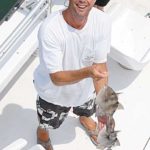
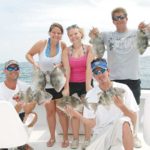
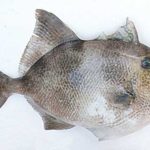
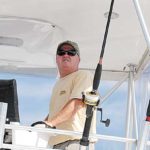
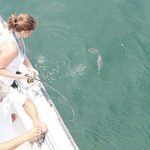



Be the first to comment